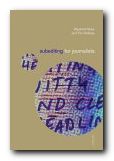the art and skills of subediting for publication
The best thing about Subediting for Journalists is that it is quite clearly based on practical experience in professional journalism. There are some interesting accounts from newspaper and magazine journalists describing exactly how they work. It’s all to do with rigour and attention to detail. They deal with the basics of house style – adhering to a set of standards in spelling and representation. This means taking care with punctuation and grammar, spotting cliché, and getting names right.
 Most of what they have to say concerns correcting common mistakes – dangling participles, misused phrases, and unnecessary repetition. Anyone who wants to improve their writing skills could learn valuable lessons here. They also cover all those grammatical niceties such as that/which and who/whom which you look up then forget about by the next time you need to use them. The advice they give could not be more up to date:
Most of what they have to say concerns correcting common mistakes – dangling participles, misused phrases, and unnecessary repetition. Anyone who wants to improve their writing skills could learn valuable lessons here. They also cover all those grammatical niceties such as that/which and who/whom which you look up then forget about by the next time you need to use them. The advice they give could not be more up to date:
your publication …. could be printed, it could be uploaded onto a website, it could be cannibalised for delivery to WAP or G3 mobile phones and it could also appear on television.
There are plenty of examples of re-written news items which illustrate the advice being given. They deal neatly with issues of names, dates, places, accuracy, and getting to the point. There are sections on writing headlines and photograph captions. These need to be snappy, but the advice is the same in both cases – make it accurate.
They outline the main legal and ethical problems confronting subeditors – issues of copyright, libel, slander, defamation, and contempt of court.
They also explain the print production process. This includes the use of computer software such as Quark Publishing System (QPS) to control what can become a very complex collection of documents. It’s like a peek behind the scenes for the uninitiated.
There’s also a chapter on print technology which won’t tell you much about subediting, but which is a fascinating sketch of the revolution which took place in 1983 when hot metal was replaced by digital typesetting.
They finish with a chapter on subediting web pages. They conclude with a glossary of journalism terms, a sample house style guide, and standard proof correction symbols in UK and US style.
This is a good book. It’s readable, written by people who are clearly well-informed, and just about as up-to-date as it’s possible to be in the old-ish world of print publication.
© Roy Johnson 2002
Wynford Hicks and Tim Holmes, Subediting for Journalists, London: Routledge, 2002, pp.180, ISBN: 0415240859
More on journalism
More on creative writing
More on writing skills
More on publishing